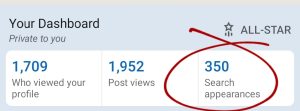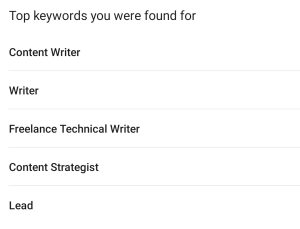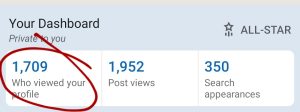It’s only natural for copywriters using LinkedIn for their own marketing to measure success by the numbers that are visible by default ─ number of Likes, comments, views, and followers.
However, a lot can go wrong inside of our own marketing when that habit turns into an obsession for those numbers.
Let’s look at a few reasons why Likes and comments can be misleading metrics, what to focus on instead, and a few ways to capitalize on the real numbers that matter.
Why Likes and Comments Present a False Picture
Not All Influencers Earn Well
This is a lesser-known fact, but not all accounts with over 50K followers are earning as well as you’d think. Why is that? Because these business owners got trapped in the mindset of metrics and forgot to stick to their brand, deliver value, and convert.
To find the right clients for your business on LinkedIn, you want to let go of the idea of vanity metrics and stay focused on the real numbers ─ leads in the pipeline and money in the bank. Because the bottom line is, Likes and comments do not pay bills.
Focusing on Likes and Follower Counts Could Harm Your Brand
Another reason why focusing on vanity metrics can be detrimental to your brand is because it builds up a bias in your mind toward content that may be entertaining or viral material, but not aligned with your brand or your target audience.
Remember, your marketing needs to serve a specific community of people. And what good are a 1,000 Likes if they don’t inspire, educate, or nudge your ideal clients into hiring you?
Don’t Forget the Lurkers
In my experience, some of the prospects who convert into paying clients never even engaged with my content.
They just see from a distance and each time you show up with a meaningful message, it registers in their mind.
Not all of us ‘Like’ everything we like on social media.
Some prospects choose to silently consume and move on. And so the number of Likes is a falsified way to measure your marketing success on LinkedIn.
Do You Need 20,000 Followers or 20 High-Quality Leads?
Let’s be honest. What is the real number we’re chasing as copywriters and freelance writers? 20 high-quality prospects who can pay our rates and agree to reasonable terms? Or 20,000 followers who are only there for the free content?
What to Focus on Instead
Now that we’re no longer considering the flawed metrics, here are the ones to realistically measure your LinkedIn marketing efforts.
Search Appearances
This little metric presents itself on your LinkedIn profile dashboard. Basically, it indicates how many times you were listed in a search result on LinkedIn. Yes, your ideal clients use LinkedIn as a search engine to look for freelance writers and copywriters.
We’re not just interested in the number here, but also the keywords we get found for. To improve the quality of your Search Appearances, to get found for the right keywords, integrate them into your LinkedIn profile. We’ll talk about that in the next section.
Profile Views
Profile views indicate how many people viewed your profile. And again, we’re not just interested in the number, but the kind of people (not judging!) discovering us on LinkedIn.
What impacts the quality of this metric is the content we put out on LinkedIn, how relevant it is to our ideal client, and our overall activity on LinkedIn.
Bonus tip: Once a week, go through your profile viewers and send a connection request to those that match your ideal client persona.
Leads in the Inbox
A great measure of your LinkedIn marketing is the number of leads you get in the inbox per week. It’s also a good idea to rate these leads as highly relevant, mildly relevant, or not relevant.
Of course, you get to decide which leads are highly qualified to convert into clients… for you. Make a list of qualities in your ideal client that you look for — like budget to pay you, organization size, terms of payment, willingness to accommodate change, and more.
Money in the Bank
Are you easily converting the highly relevant leads to clients? Why or why not? Does it have anything to do with the quality of your marketing? The ball does not stop with getting the lead in the pipeline but starts rolling when that happens.
While the process of converting leads has many factors involved, it’s good to reflect on how many high-quality leads you were and weren’t able to convert any given month and why.
3 Tips to Improve the Metrics that Matter
Create Targeted Content That Attracts, Interests, Educates, and Converts Your Ideal Clients
Keep your ideal clients front and center when brainstorming and creating content for your own marketing. Learn more about the most effective post examples to attract your ideal clients in this article.
When you are laser-focused with the messaging you send out, you get better profile views, more relevant prospects, and higher conversions rates from all the credibility you’re building with your content.
Hangout with Your Ideal Client Persona
Intentionally engage with your ideal clients on LinkedIn. Engage with posts in relevant hashtags, let’s say ─ #fitness, #health, or #technology based on your writing niche.
Connect with marketing managers at organizations that qualify as your ideal clients. Make a list of companies you want to work with and start intentionally engaging with the marketing or content manager there.
Deliberately getting visible in circles where your ideal clients are also hanging out can be a great way to get relevant profile views and leads in the door.
Maintain a Relevant Profile to Convert Prospects Better
Maintaining a highly relevant profile can help you improve your Search Appearances both qualitatively and quantitatively. Use relevant keywords (that your ideal clients use to search for you) on your LinkedIn profile, especially in the headline, About section, experiences, and skills.
Not only that, a highly relevant profile also makes converting easy. When your ideal clients land on your profile, it either makes or breaks the deal. Ensure that you’re speaking to your ideal client throughout your profile.
To intentionally work on your LinkedIn profile for better conversions and visibility, check out this Inside AWAI webinar with Rebecca, Katie, and Ilise Benun.
Likes and comments are an obsolete way to measure your LinkedIn marketing. Instead, focus on metrics that really matter and take easy steps to optimize them.



